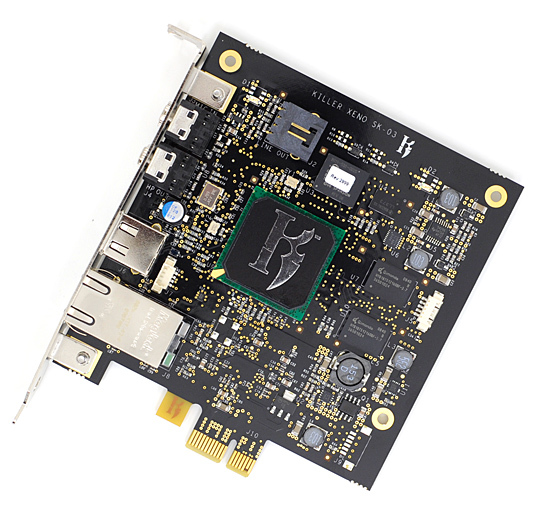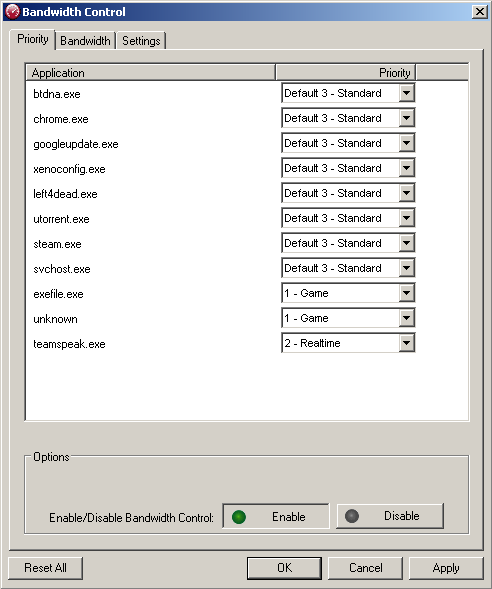EVGA Killer Xeno Pro: The Impact of Network Offloading
by Derek Wilson on July 3, 2009 4:20 AM EST- Posted in
- Networking
The Card and Features
This card sports a 400MHz PowerPC processor with 128MB of RAM, essentially making the Killer Xeno Pro a computer on a x1 PCIe board. As with the first generation, the major feature of the Killer Xeno Pro is it's ability to offload TCP/IP work from the CPU by bypassing the Windows TCP/IP stack.
Microsoft's built-in TCP/IP stack requires the CPU to handle network packet processing. Additionally, when packets arrive, they don't generate interrupts and applications must poll for data (which also wastes time and resources). Bigfoot Networks claims that the windows networking stack is not designed for low latency operation while the Killer Xeno Pro is. Regardless of how (or how efficiently) a software network stack is implemented, having it run in hardware will reduce overhead and impact on the rest of the system. It should also be noted that, for applications which require the windows networking stack (like some VPN products), the Killer Xeno Pro can disable it's "game mode" and enable "application mode" which does disable TCP/IP offload and can increase compatibility in some cases.
Adding to this, the Killer Xeno Pro hardware is capable of offloading other network centric tasks like VoIP, firewalls, and networked storage (though these features are not all fully supported with appropriate software at this point in time).

Installing the hardware is very straight forward, as it's just a simple PCIe card. If you want to use the voice chat features, the only additional need is to connect either the internal or external audio cable. No power is required, and other than that the network port is all that you'll need to worry about. Despite the fact that there is a USB port on the card, it is not used for anything at this point (but Bigfoot has indicated future potential to enable hardware managed USB attached storage).

Mic in and audio line out on a NIC; now that's a first.
The only installation issue we noted is that the driver install, when necessary, will also flash the Killer Xeno Pro hardware. There isn't very much warning about what's going to happen and no confirmation dialog before the start of the flash process. Those who click through install programs quickly without reading them might get themselves into a bit of trouble. There is no way to cancel the flash update once it's started, and while flashing hardware isn't as risky these days, it might be nice if the drivers were a little more clear about what was going to happen.

Easy mode switching.
The hardware comes with drivers and a tray application that are capable of bandwidth throttling and prioritization. Control can be down to a per application basis and maximum download and upload speeds can be specified. Or for benefit without the headache, applications can be prioritized allowing hardware and usage patterns to determine effective bandwidth. Unfortunately, the drivers and applications for the Killer Xeno Pro only run on Microsoft Windows operating systems (XP and Vista flavors). With the gaming focus, this makes sense, but it would still be nice for those who like to dualboot Mac OS X or Linux.

Per application QoS.

Per application bandwidth limits.
With software support, games and voice chat software can completely delegate any VoIP functionality to the Killer Xeno Pro which would handle taking input from the microphone (which plugs straight into the Killer Xeno Pro), compressing the data and sending it out over the network. When a voice packet is received by the Killer Xeno Pro, it decompresses it and sends it straight to the sound card (either via the soundcard's line-in port or an internal cable) bypassing the rest of the system completely. This should help reduce CPU overhead and voice lag caused by sources other than the network or server.
While this is great from a geeky technical standpoint, there isn't a huge amount of overhead on modern CPUs for voice chat software, and the network is by far the largest source of delay. So the actual benefit isn't going to be huge. These issues are the same with hardware firewall, bandwidth control, and all the extras.
The TCP/IP offload capability of the hardware will definitely remove another task from the CPU and operating system. This will free up resources that could be useful for other things, but the real world benefit of this will be very small in most games where the majority of the work is done on the GPU rather than the CPU. Having an NPU (network processing unit, as Bigfoot Networks likes to call it) that handles TCP/IP processing as soon as packets are received and uses hardware interrupts to let a game know that network packets have arrived (rather than requiring polling) can help decrease the latency between when a packet is received by the network card and when a game is able to make use of it, but as with the voice issue the largest delay is inherent in the internet itself and there is only so much benefit that can be had by optimizing the client side.
Not to say that optimizing client side networking is a bad thing: it certainly is not. The real question here is not whether the Killer Xeno Pro does something useful (because it does), the question is whether that useful thing has any significant impact on experience (and if that impact is high enough to justify the price).










121 Comments
View All Comments
tamalero - Saturday, July 18, 2009 - link
just wondering guys, why you didnt test on a NORMAL machine and not on a high end machine?to test the offloading, you should have used games that are heavily cpu bound or that limits cpu or similars.
a dual core machine with some heavy source based engines and see if it offloads the cpu....
if you're not gonna squish what the card promises, why even test then?
kmmatney - Friday, July 10, 2009 - link
A more useful article would be whether a sound card improves performance - I'd like to see a good article on that.hoak - Friday, July 10, 2009 - link
I hope this isn't a trend, but this review and others like it on AnandTech are not of the caliber of other of reviews past, or what's offered on other sites like X-Bit Labs where rigorous objective testing standards, science, and hard facts are the arbiter of a review, not this subjective and half-assed swill that panders to the the difficulty of testing and baseless opinion.Five Frowny Faces For AnandTech...
:( :( :( :( :(
LoneWolf15 - Thursday, July 9, 2009 - link
"Adding to this, the Killer Xeno Pro hardware is capable of offloading other network centric tasks like VoIP, firewalls, and networked storage (though these features are not all fully supported with appropriate software at this point in time)."This is the ONE use I would find for this card, rather than gaming. I know people who rely on VOiP, or teleconferencing for distance-learning and therapy who could truly benefit from what this card has to offer. And of course, most of those features aren't fully supported.
Hmm. Think I'll just make sure those people have a fast enough CPU to crunch things (which really isn't all that fast, a Core 2 Duo P8400 on a laptop can handle it no problem) and a low-latency network, since I probably can't guarantee even, consistent support with something like this product. Maybe someone like Cisco can buy the company or Killer NIC can look at the business aspect of this, since I think they'd make more money there, and then be able to use it to support the gaming side of things.
jiulemoigt - Wednesday, July 8, 2009 - link
I started reading through the comments to see if anyone posted this but the whole test was invalid. Two computers with the exact same hardware going to a location on internet could have totally different latencies because they took different routes to get to the host server.Though the results reflewct reality some times it is going to be fast some times it is going to be slow, but mostly it is dependant on how congested the net in general and how busy your server is. The network stack is not significant to transfering data unless something is broken.
Last most built in NIC have traces directly to the north or south bridge depending on the chip and don't share bandwidth with anything else.
swaaye - Friday, July 10, 2009 - link
Onboard NICs are either on PCI or PCIe and definitely do share with other such devices.Teloy - Wednesday, July 8, 2009 - link
«the Killer Xeno Pro can disable it's "game mode" and enable "application mode»; «(...)the major feature of the Killer Xeno Pro is it's ability to offload TCP/IP work(...)... "It's" is a typo only allowed to first grade children... You should pay more attention to grammar when writting an article on a website as prestigious as Anandtech...jaggerwild - Tuesday, July 7, 2009 - link
I have to question why this article was done, unless EVGA is buying space here.........Rasterman - Monday, July 6, 2009 - link
One question that would put things into perspective is how much CPU is used to do TCP/IP functions? My guess is a tiny fraction of 1%, especially with a monster CPU like in the test. Therefore even if you offload 100% of network computation, you are never going to notice a difference.It seems this card might be more useful for a web or file server. Testing it in a system with as high of a network load as possible would seem to be a much better test if the card is actually doing anything. Granted people are going to buy this for games, but the problem testing with games is they are designed to use as little network as possible.
hooflung - Monday, July 6, 2009 - link
Q: Who else would benefit from using this product?A: Among other things, Killer is a UDP (User Datagram Protocol) accelerator, so other applications that are UDP intensive could also see benefits. In addition, programmers, Linux developers, and other enthusiasts will love FNA because they will be able to write or download Flexible Network Applications that run on Killer's NPU. Flexible Network Applications could be VOIP apps, peer to peer file sharing utilities...the list is endless.
Q: Some of the articles about your card say you offload TCP/IP. Is this true?
A: While our card does perform some TCP/IP acceleration functions, it does not fully offload this network protocol (nor does any other network card in the consumer market today). Most MMO and First Person Shooter online games don't use TCP/IP as the primary protocol, but rather use UDP. Among other things, Killer IS a UDP (User Datagram Protocol) accelerator, which makes it EXTREMELY FOCUSED on gaming, and very different from what any other company is offering today.